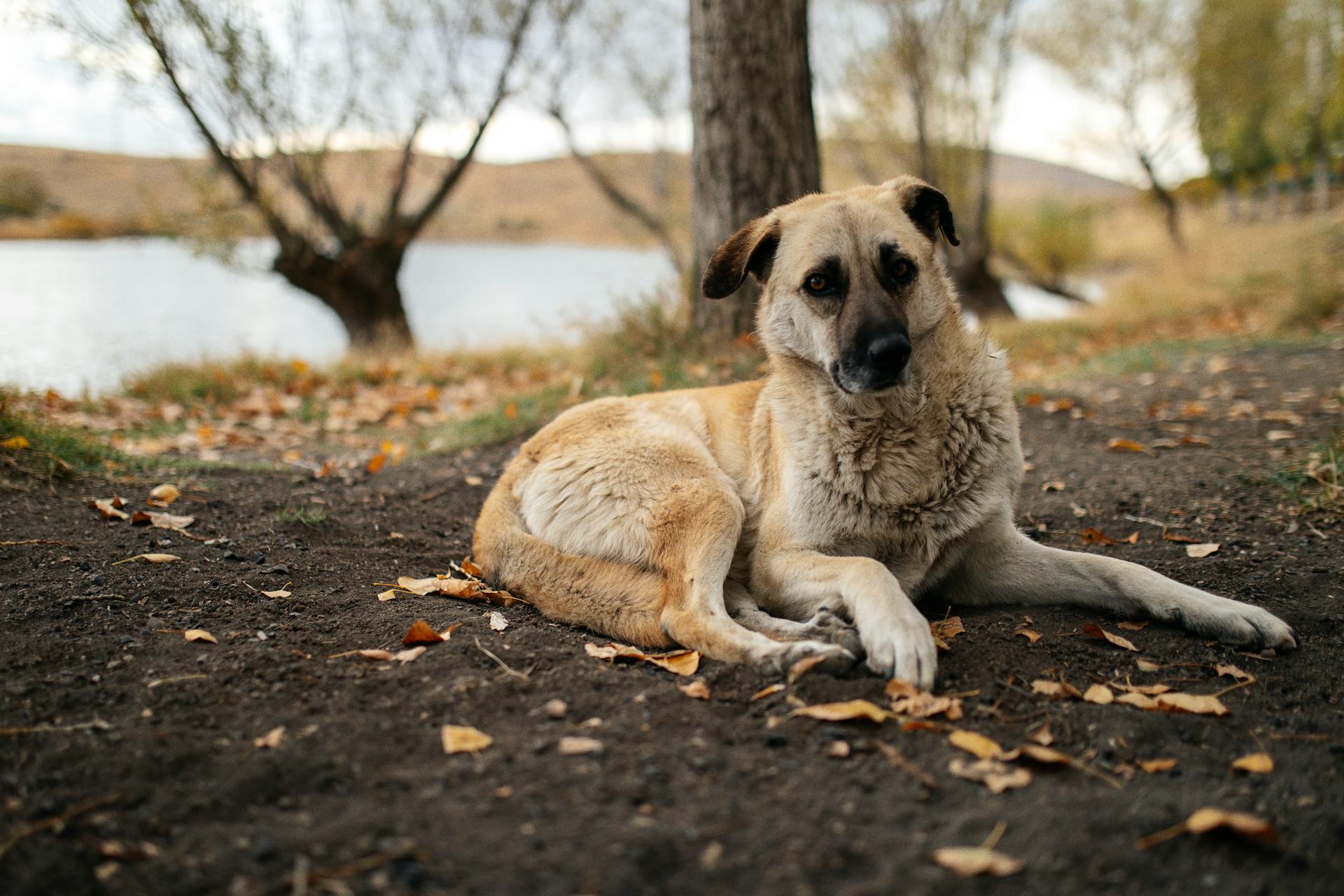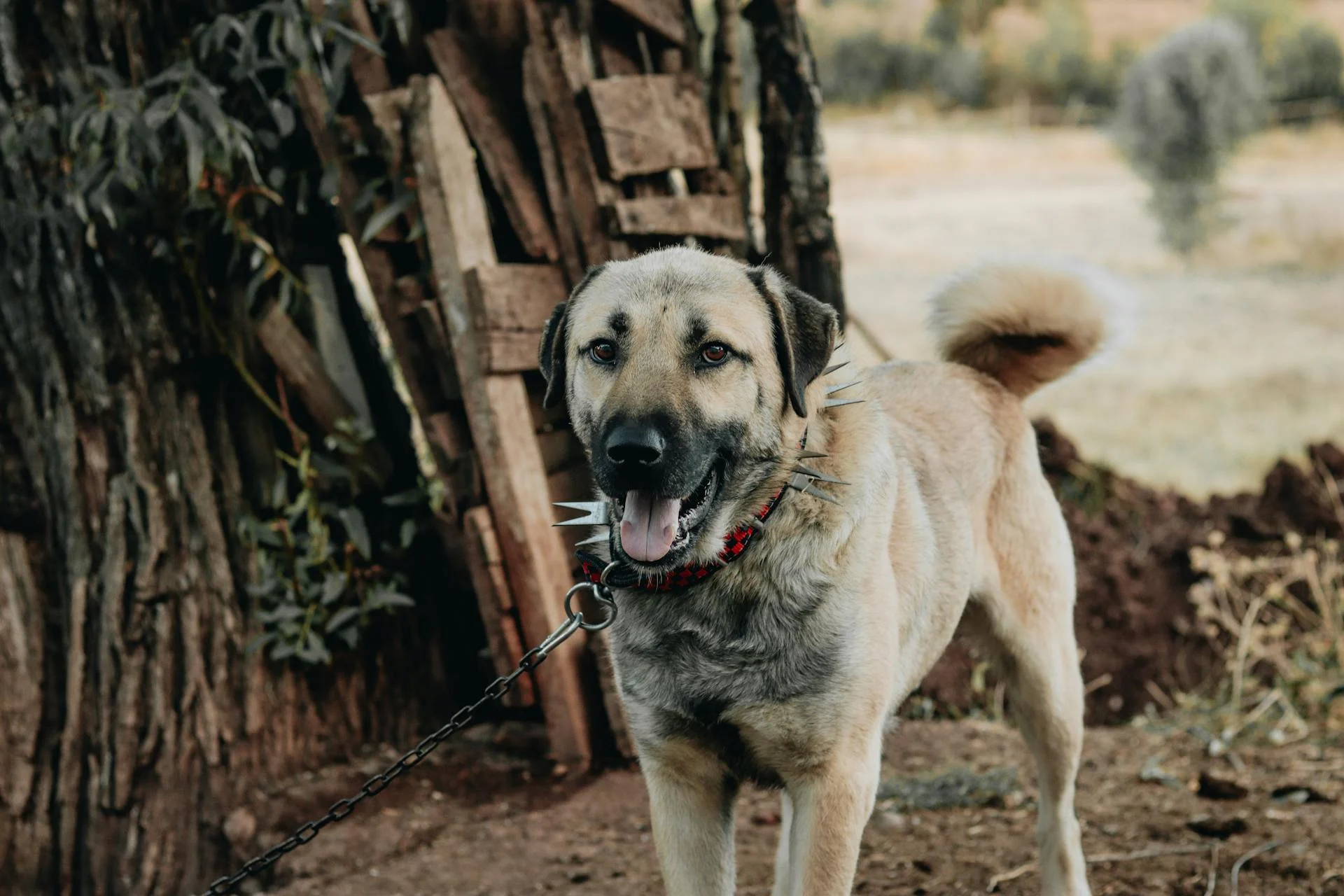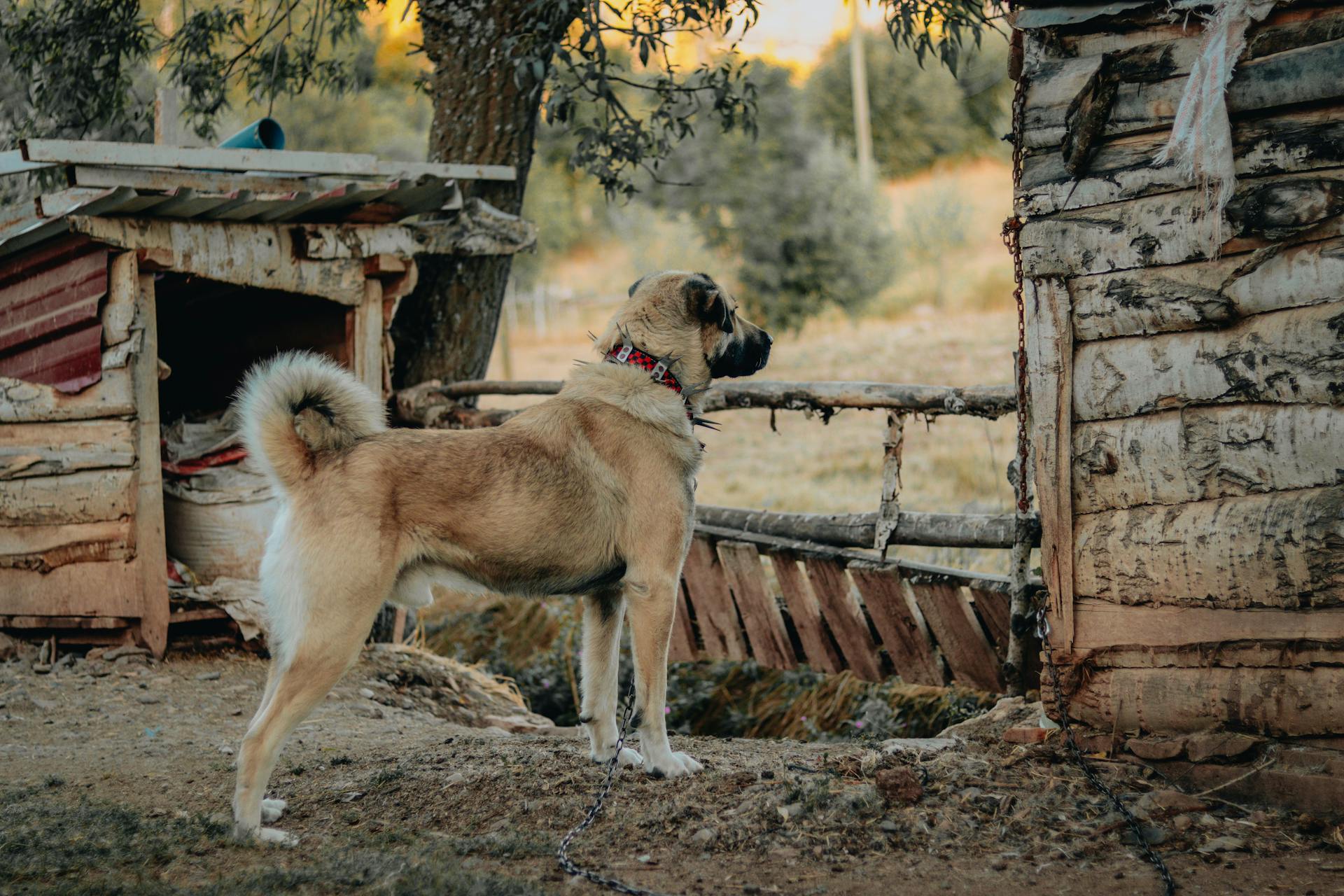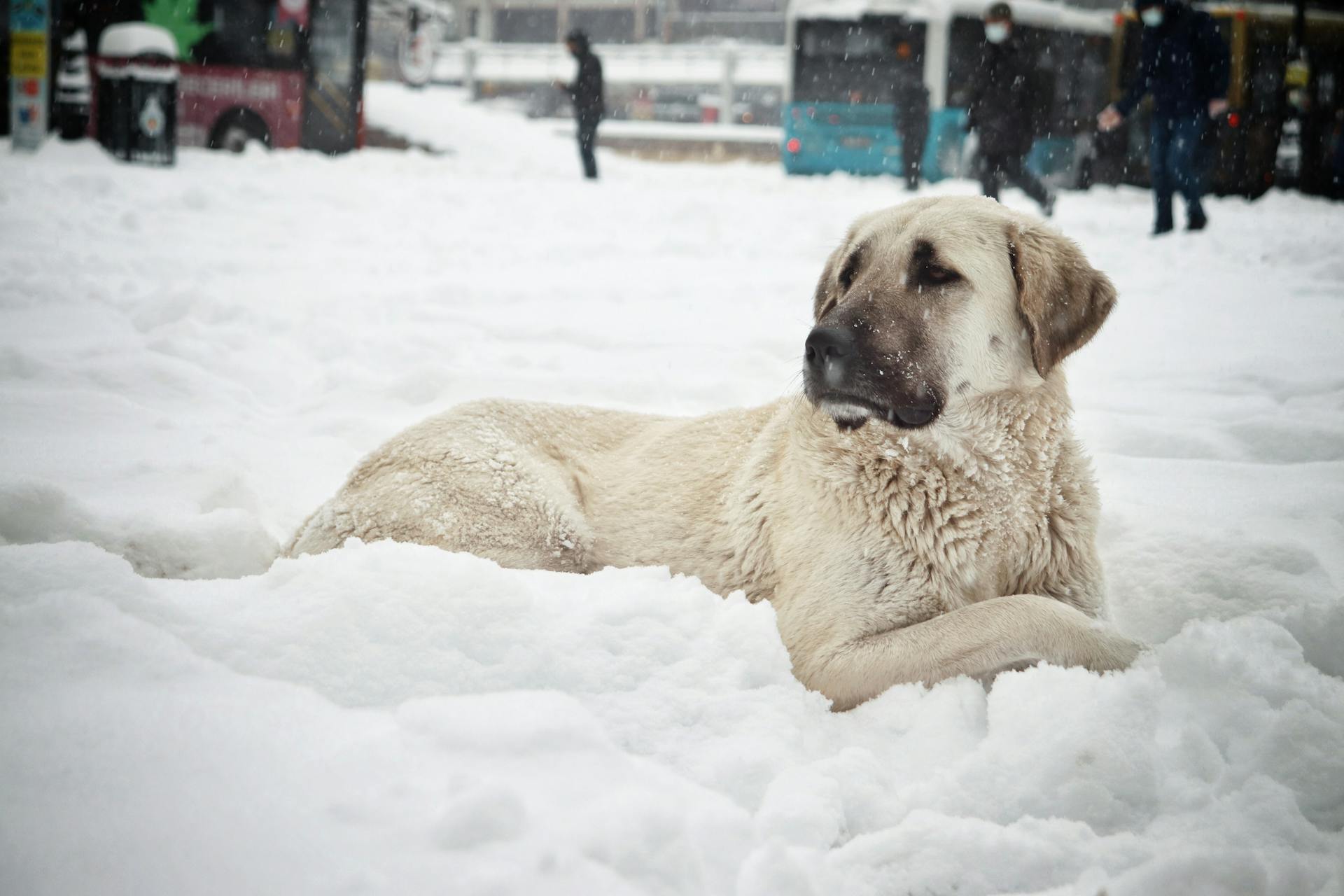
The Kurdish Kangal is an ancient dog breed originating from Turkey, specifically from the Kurdish region. They are a rare breed, known for their distinctive physical characteristics and impressive guarding abilities.
Their thick, double coat is a mix of white, black, and tan colors, with a characteristic white blaze on their forehead. This coat helps them thrive in harsh climates.
Kurdish Kangals are large dogs, with males weighing between 110-145 pounds and standing 30-32 inches tall at the shoulder.
Physical Characteristics
The Kurdish Kangal is a large dog with a light tan coat, black shadowing around the nose, and dark floppy ears.
They have a muscular build that can appear intimidating, and their tails curl up with the tip facing their backsides.
On average, these dogs weigh between 121 to 143 pounds and stand between 29 to 33 inches tall. Males are typically larger than females.
Their coats shed during spring and winter, so be prepared for some extra grooming during these seasons.
Height & Weight
The Kangal Dog's height and weight are an important part of its physical characteristics. Typically, males reach a height at maturity of 29 to 33 inches measured at the withers.
Females are slightly smaller, ranging from 27 to 31 inches.
Males can weigh anywhere from 110 to 145 pounds in good condition.
Females usually weigh between 90 to 130 pounds.
As long as overall balance is maintained, height and weight in both sexes can exceed these ranges without penalty.
Broaden your view: A Guide to Managing Healthy Weight in Your Dog This Summer
Forequarters
The forequarters of a dog are a crucial part of its overall physique. The shoulders are well muscled and moderately angulated.
The front quarters are slightly heavier in proportion to the hindquarters. This is a notable characteristic that sets them apart.
The forelegs are long, well boned, and set well apart. This allows for a wide range of motion and flexibility.
Strong, slightly sloping pasterns are a key feature of well-proportioned forequarters. This helps to distribute the dog's weight evenly.
The elbows move freely and close to the sides. This is essential for smooth movement and agility.
Loose shoulders or elbows in mature dogs can be a fault. This can affect the dog's overall health and mobility.
Bowed front legs are also a fault, making it difficult for the dog to move comfortably.
Body
The Kangal Dog's body is a powerful and muscular one.
The topline of a Kangal Dog inclines very slightly downward from the withers and then rises with a slight arch over the loin.
The loin is short and muscular, blending into a moderately short and slightly sloping croup.
The ribs of a Kangal Dog are well sprung, which is a desirable characteristic.
The chest is moderately wide and deep, with the brisket extending down to the elbow.
Tuck-up is moderate in a Kangal Dog.
Tail
The tail of a Kurdish Kangal is quite distinctive. It's thick at the base, undocked, and tapers to the tip.

Their tail hair is slightly fuller on the tail than on the rest of the body. When the dog is relaxed, the tail reaches at least to the hock.
When the dog is alert, the tail is carried in a curl over the back. This curl can be tight or loose, but when the tail is curled upright, the tip of the tail may fall off to one side of the hip.
The tail's length and curl are important characteristics to consider.
Coat
The Kangal Dog's coat is quite unique. It's a fairly short double coat that adjusts to the weather.
In cold weather, the coat becomes very dense and nearly uniform in length. This helps keep the dog warm.
Here's an interesting read: Shiba Inu Coat
Kangal Characteristics
The Kangal Dog's temperament is a key part of its characteristics. It's alert, territorial, and defensive of its family and the animals it guards.
Kangal Dogs are naturally strong and fast, making them well-suited to confront threats to their flocks. They prefer to intimidate predators, but will take a physical stand if necessary.
These dogs are generally reserved with strangers, but are not typically belligerent toward people. They become more confident when their owner is present and offering reassurance.
Their instinctive wariness of strange dogs is a trait that serves them well in their role as livestock guardians.
Strong Bite Force

The Kurdish Kangal's bite force is truly impressive, with a whopping 743 pounds per square inch, making it the heaviest bite among all breeds.
This means their bites can be painful and quite destructive to intruders and predators, serving as a strong defense mechanism for the dog.
Behavior and Temperament
Turkish Kangals have a heart of gold when it comes to family, but they can be protective of their loved ones.
They can learn to tolerate anyone without feeling the need to attack if trained early in life.
Raising them around people when they are puppies can help them adapt to different personality types as adults.
Gait
The Kangal Dog's gait is a reflection of its unique combination of strength and agility. Its natural gait is relaxed and efficient, with strides of moderate length.
At a walk or slow trot, the Kangal Dog's back and neck are level, showing its ability to maintain a steady pace. This level posture also indicates that the dog is feeling calm and relaxed.
As the dog's speed increases, it may start to single track, where it focuses on one track or path rather than alternating between two. This is a natural response to increased speed and shows the dog's agility.
Here's an interesting read: Why Are My Dog's Nails Splitting?
Behavior/Demeanor
Turkish Kangals are known to have a heart of gold when it comes to family, but they can be fiercely protective of their loved ones.
Raising them around people when they're puppies can help them adapt to different personality types as adults, making them more tolerant of strangers.
Their natural instinct is to defend their family and territory, so early training is crucial to teach them to differentiate between threats and harmless individuals.
With proper training, they can learn to tolerate anyone without feeling the need to attack, making them wonderful companions for families.
Kangals are highly intelligent and can pick up on subtle cues, but they can also be independent and stubborn at times, requiring patient and consistent training.
Health and Care
Kurdish Kangals are generally a healthy breed, but they can be prone to hip and elbow dysplasia, a condition that causes joint pain and stiffness.
This condition can lead to gait disabilities if left untreated.
To manage the condition, your veterinarian may recommend anti-inflammatories and surgery.
Lipomas, fatty lumps on the chest and abdomen, are another common issue in Kurdish Kangals.
These growths are usually benign and painless, but they can become large and annoying.
If necessary, a veterinarian can remove the lipomas to alleviate discomfort.
Eyes
The eyes are a vital part of your pet's overall health, and there are some specific characteristics to look out for. Eye color ranges from deep brown to amber.
Having pale yellow eyes is considered a serious fault, so it's essential to keep an eye out for this.
Eye rims that lack solid black pigment are also a serious fault.
Kangal Health
Kurdish Kangals are one of the healthiest breeds of dogs, but they can still develop health problems.
Hip and elbow dysplasia can affect Kurdish Kangals, causing pain and stiffness due to a joint that becomes out of place.
This condition can lead to gait disabilities if it worsens.
Broaden your view: Kurdish Kangal Dog Breed
Anti-inflammatories and surgery can help correct the problem.
Lipomas, or fatty lumps, can develop on the chest and abdomen of Kangals, and are usually benign and painless.
However, they can become large and annoying, and a veterinarian can remove them if necessary.
As Kangals age, they can also become overweight, which can lead to other health issues.
Turkish Kangals are prone to ligament injuries, arthritis, and heart disease.
Grooming
Grooming is an essential part of Kurdish Kangal care, and it's not just about making them look good. They shed twice a year, which means daily brushing is a must in the spring and winter.
Their thick coats require gentle care, so monthly bathing is recommended to avoid stripping them of their natural oils.
To prevent matting and tangling, brush your Kurdish Kangal every day during their shedding months.
Kurdish Kangals are prone to drooling, so it's crucial to practice good oral care, brushing their teeth at least twice a week.
See what others are reading: Cockapoo Care
Caring for a Dog
Caring for a dog requires attention to their physical and emotional needs. They need regular exercise to stay happy and healthy.
For example, Kurdish Kangals need daily walks and regular contact with familiar humans to prevent boredom and destructive behavior.
Dogs also require training, which should be done with patience and positive reinforcement. They can be challenging to discipline, so it's essential to understand their needs and boundaries.
Regular training sessions can help prevent aggressive behaviors and strengthen the bond between dog and owner.
Broaden your view: Shiba Inu Exercise Needs
Kangal Dog
The Kangal Dog is a majestic breed that originates from Turkey, specifically from the Sivas region. They are a type of livestock guardian dog.
These dogs are known for their distinctive white or cream-colored coat with a black mask, which helps to protect them from the harsh sun. They are also incredibly intelligent and easy to train.
One of the most notable characteristics of the Kangal Dog is their size - they can weigh up to 145 pounds and reach a height of 32 inches at the shoulder.
History
The Kangal Dog is an ancient flock-guarding breed, genetically related to the livestock guardian dogs found today in Central Asia. These dogs were brought by nomadic Turkic tribes who migrated into modern day Turkey in the 11th Century.
The breed is named after the Kangal District of Sivas Province in Central Turkey, but they were historically found throughout the high Anatolian plateau. This region is known for its rugged terrain and harsh climate, which likely contributed to the breed's remarkable uniformity in appearance, disposition, and behavior.
Both landowners and shepherds took great pride in the Kangal Dog's ability to guard their flocks of sheep and goats from traditional predators. The dogs were highly valued for their bravery and loyalty.
The Kangal Dog was first imported to the United States in 1985 by David and Tudith Nelson, who conducted fieldwork on livestock guardian dogs in Turkey in the 1970s.
Suggestion: Kangal Dog Price in Turkey
Kangal Dog
The Kangal Dog is a large and powerful breed, weighing between 110 and 145 pounds.
They are originally from Turkey and have been used for centuries as livestock guardians.
Their distinctive coat is thick and rough, with a white or fawn coloration.
Kangal Dogs are known for their loyalty and protective nature, making them excellent guard dogs.
They are also highly intelligent and trainable, but can be independent at times.
Their strong instinct to protect their flock means they can be wary of strangers and require early socialization.
With proper care and attention, Kangal Dogs can thrive as beloved family pets.
Photos and Appearance
The Kangal Dog is a large and powerful breed, with a size and proportion that has developed naturally over time as a result of its use as a guardian against predators.
They have a distinctive head shape, with a large and moderately wide head and drop ears. Their double coat is moderately short and quite dense, with a dark or black mask and ears that contrast with a body color that can range from cream to pale tan or fawn.
You can find a variety of photos of Kangal Dogs online, with over 570 stock photos and images available to browse. They are often depicted in traditional Turkish settings, such as in the countryside or at cultural festivals.
See what others are reading: Idiopathic Head Tremor in Dogs
General Appearance

The Kangal Dog is a large and powerful dog, whose size and proportions have developed naturally as a result of its continued use in Turkey as a guardian against predators.
Its head is large and moderately wide with drop ears.
A properly proportioned Kangal Dog is slightly longer than tall.
The length of the front leg should equal slightly more than one-half of the dog's height.
The tail is typically curled, completing the distinctive silhouette.
The Kangal Dog has a double coat that is moderately short and quite dense.
The body color may range from cream to pale tan or fawn, but can appear gray when there are more dark (sable) hairs in the outer coat.
A dark or black mask and ears contrast with the body color.
Honorable scars or other evidence of injury resulting from working in the field are not to be penalized.
Suggestion: Dogs with Pointy Ears Breeds
Kangal Dog Photos
You can find a vast collection of Kangal dog photos online, with over 570+ images available.
These photos showcase the beauty and majesty of the Kangal breed, which is also known as the Anatolian shepherd dog.
The Kangal dog is a Turkish national shepherd dog, known for its bravery and effectiveness in protecting its flock from wolves and wild animals.
You can find photos of Kangal dogs in various settings, from portraits of young females to images of them working as livestock guard dogs in harsh climates.
One photo shows a purebred Sivas Kangal dog tied up in a chain in a garden in Turkey, highlighting the breed's versatility.
In Turkey, Kangal dogs are often seen accompanying men in traditional dress, as in a photo from the 2019 Etnospor cultural festival.
The breed's ruggedness is also evident in a photo of a Turkish Kangal dog on a pasture in winter, showcasing its ability to perform its duties in extreme conditions.
If this caught your attention, see: Giant Turkish Kangal Dog
Frequently Asked Questions
Are kangals legal in the US?
Kangal dogs are generally legal in the United States, but local regulations and insurance policies may apply. Check your area's breed-specific laws and insurance requirements before bringing a Kangal home.
Is a Kangal a good family dog?
Yes, Kangal Shepherd Dogs can make great family pets due to their loyal and protective nature, but they also value their independence and may require extra attention and training. With proper care, they can form strong bonds with their family.
Can a Kangal be a house dog?
Yes, a Kangal dog can thrive in a household setting with proper care, but they require regular exercise, mental stimulation, and obedience training. With the right attention, a Kangal can make a wonderful and loving companion.
Sources
Featured Images: pexels.com


